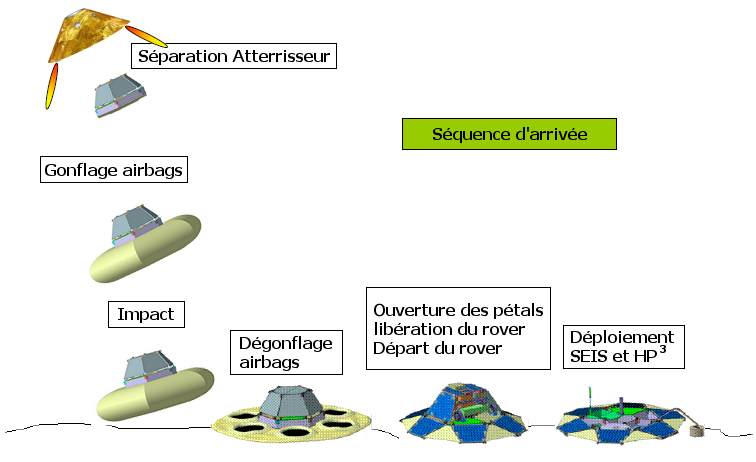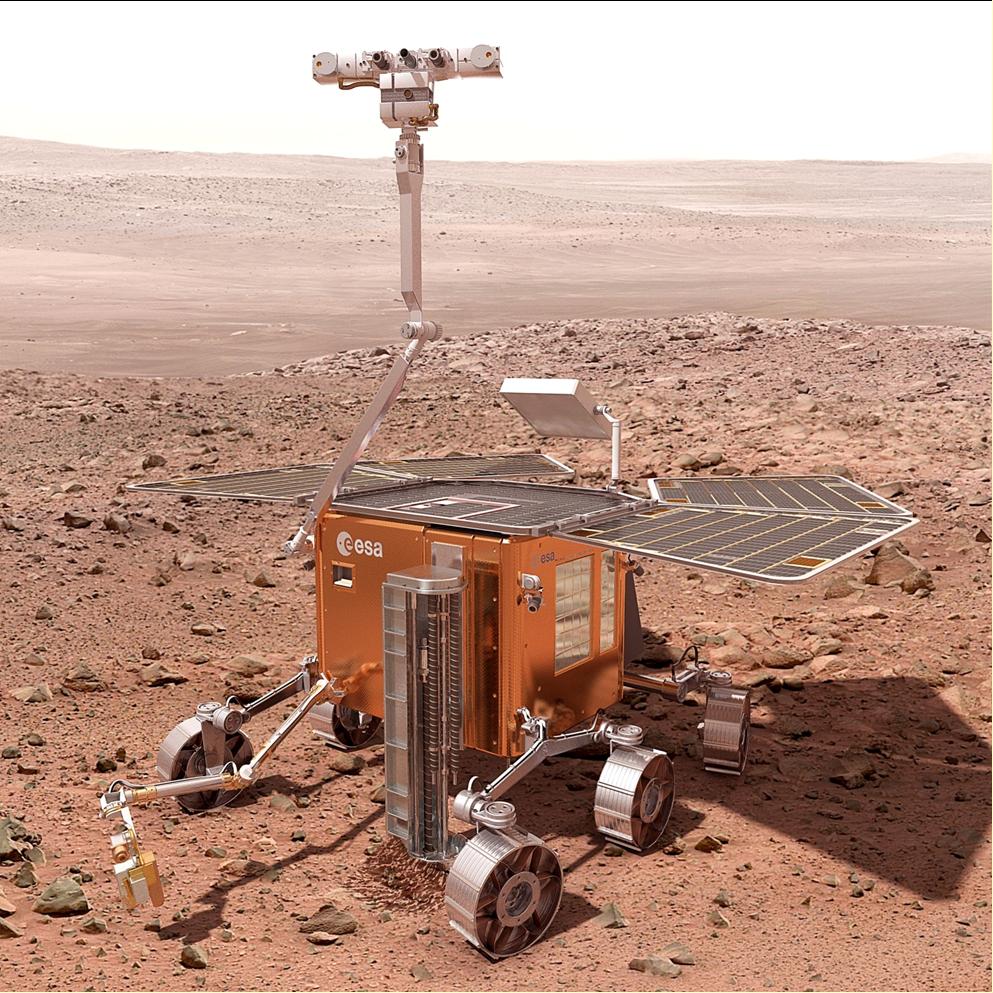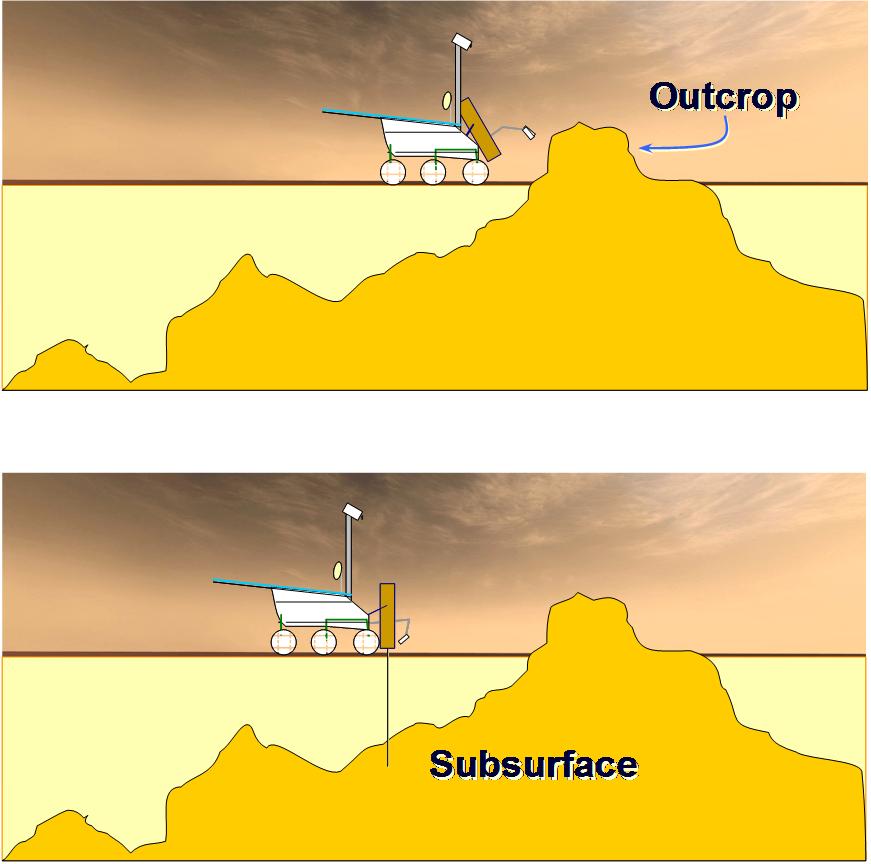Objectives
The future Mars missions aim at increasing our scientific knowledge about the planet Mars and our technology capability to land the spacecraft safely.
More precisely, the scientific objectives are :
- The seek for past or present life on Mars;
- The characterization of water distribution and geochemistry in function of depth in the soil ;
- The study of the environment on the surface and the identification of risk for a future human mission ;
- The study of the interior of Mars in order to gain a better understanding of the evolution of the planet and its habitability.
The technological objectives to be achieved are :
- The management of the entry into the atmosphere, descent and landing of the probe on the surface of Mars ;
- The acquisition of mobility on Mars in a radius of several kilometers with a Rover ;
- Sampling on Mars at a depth of two meters with a drill;
- The preparation of samples for analysis and results distribution.
These objectives will be achieved by two sets of instruments: a first set on board a Rover, thus mobile, equipped with instruments for soil and sub-soil sampling (Pasteur payload), and a second set on a surface module/lander (Humboldt payload or GEP, Geophysics Environment Package).
Mission Scenario
The travel to Mars will last about ten months. The probe will consist of the cruise module (CM) and the descent module composite (DMC). The cruise module will carry the descent module from Earth to Mars. It will orbit around Mars and wait until conditions are favorable to release the DMC. Indeed, there may be at this time of the Martian year tornadoes of dust that can damage the mission. At the right moment, the DMC will be launched on its particular descent trajectory. The module will continue its cruise trajectory, return to the atmosphere of Mars and burn, while the DMC will land on the surface of Mars and deploy the Rover or the lander.
 |
|
|
Landing of ExoMars mission - Credits Thalès Alenia Space
|
The spacecraft
The spacecraft consists of :
- A cruise module (CM) that carries the descent module.
- A composite descent module (CDM) which makes entry into the atmosphere, descent and land on the surface of Mars. To allow a landing in optimal conditions, the CDM has a heat shield, a parachute system, a jet control system, descent thrusters and a lander. The landing can be done with a new airbag system that enables landing without bouncing. The advantage of this arrangement is that there is no need to surround the whole CDM with airbags as it was the case in previous missions, which represents a gain of space. Once landed, the CDM releases the lander or the rover. The ExoMars Rover is a 250kg Rover containing itself the 16.5kg Pasteur scientific payload. The future lander(s) deploys the Humboldt scientific payload.
The Rover and its instruments
The Rover is a mobile robot with six wheels designed for research in geology and exobiology. It will travel several miles in search of signs of past or present life. It is responsible for collecting samples at and below the surface of Mars. It is therefore equipped with a drill able to sample down to two meters deep and a system that manages the collected samples, the SPDS (Sample Preparation and Distribution System). This SPDS prepares the samples, analyzes them and collect the results, which are sent to Earth. The Rover is also equipped with the payload " Pasteur ", made of eleven different instruments.
 |
|
The rover - Credits : ESA
|
The robot will use solar energy to generate the electrical energy it needs. Four solar panels covering an area of two square meters each help to survive the cold and the dark Martian nights. Equipped with panoramic cameras, it will have large autonomy, creating its own routes and avoiding collisions with the terrain if necessary. It will travel about a hundred meters a day. This autonomy is necessary because communications with Earth will be rare and short, only a two small sessions a day.
The main objective is to analyze the composition of the Martian surface by a set of instruments in order to obtain crucial measurements to characterize the chemical and mineralogical composition and identify the geological and geochemical processes,
endogenous and
exogenous processes, alteration, differentiation, tectonics, volcanoes, volatile content and formation of rocks in the mantle and surface of Mars.
 |
|
|
Observations and samples of the rover - Credits : ESA
|
The scientific " Pasteur " payload includes:
Panoramic instruments to achieve the scenic topography of the landscape, to determine where the sample will be performed, analyze the Martian atmosphere and mineralogy :
- anCam, panoramic cameras used to localize the Rover, make a topography of its environment and study the properties of the atmosphere ;
- MIMA (optional) is a spectrometer working with PanCam, used to select the sampling location. Its objectives are to determine, roughly, the mineralogical composition of the soil of Mars, observing the weather and to identify the presence of water vapor or of gases in the atmosphere ;
- WISDOM is a radar with a penetration into the soil up to three meters or better, it looks for the presence of water and characterizes the stratification of the soil ;
Contact tools to study the Martian soil:
- CLUPI (optional) is a color camera, which characterizes the geological environment and determines the details of the geological history recorded in the soil (scale micrometer up to centimeter) ;
- MIMOS II (optional) is a spectrometer, which analyzes the presence of iron in the soil to characterize the minerals and their oxidation state ;
-
Raman-LIBS is a spectrometer for analysis of Martian samples ;
- Ma_MISS is a spectrometer integrated with the drill that analyzes the composition of the soil in depth to understand the geological composition and perhaps to find signs of past or present life ;
Analytical instruments for organic and geochemical substances in the samples :
-
Micromega is an infrared and visible (optional) microscope which observes the samples and characterizes their structure and composition ;
-
Mars-XRD is a diffractometer that sends X-rays on rocks and analyses their mineralogical composition by measuring the diffraction ;
-
MOMA detects and identifies different kinds of molecules, even at very low concentrations: one of its instruments is the gas chromatograph, which detects volatile molecules in the atmosphere and sedimentary rocks ;
-
Urey (optional) is an instrument designed for the research of organic components in rocks and soil of Mars as evidence of life.
La station Humboldt et ses instruments
The geophysical station in the frame of the foreseen ExoMars enhanced payload is called the Humboldt payload or Humboldt station. The Humboldt Station was named after Alexander von Humboldt, a German naturalist and explorer of the 19th century.
The mission of the geophysical station is to explore the subsurface of Mars, to characterize its environment and to measure the orientation and rotation of the planet to understand the evolution of Mars and its habitability. On board, a typical set of instruments is the following :
-
ARES is an instrument that captures the electric fields and determines the ionization of the atmosphere. Its purpose is to measure the electrical properties of the Martian environment.
-
ATM consists in a series of environmental and meteorological sensors to study the atmosphere, the climate and its evolution, the environment of Mars and its habitability.
-
EISS is a radar that will allow us to obtain the structure and stratigraphy of the subsurface of Mars from a few tens of meters to more than one km depth.
-
The HP3 is an instrument that measures the heatflow in the soil of Mars to a depth of two meters. In the beginning, Mars was a warmer planet. But the heat is gradually draining. The details of the thermal evolution are governed by the amount of heat gained during its accretion, the abundance of radioactive elements and the nature of the convection process (movement on a large scale in the mantle of Mars). Knowing the heatflow in the soil of Mars provides a constraint on the abundance of radioactive elements and on the process of thermal evolution of Mars; this constraint will help us to better understand the biological evolution of Mars.
-
IRAS is a spectrometer. It measures the radiations at the surface of Mars and shows their different types. This will determine the amount of radiation and the risks for a future human mission.
-
LaRa (
La
nder Ra
dioscience) is an X-band transponder that will reconstruct the variations of orientation and rotation of Mars in space. For more details, click here.
-
MEDUSA is a instrument designed to study the presence of dust and water in the atmosphere. Dust detectors will determine the movements of dust grains, their quantity, the variation in size and also the probability for a grain to be electrically charged. Understanding the dust devils (tornadoes) and the cycle of dust is important to determine the damage that dust can cause to instrument or to a future human mission. MEDUSA will also measure water vapor on the surface of Mars, and eventually can be traced to the source by following the gradient of water vapor concentration.
-
MiniHUM includes two moisture sensors and two thermocouples to measure temperature changes in the soil. The aim is to understand the role of water in the last layer of soil, its influence on the chemical reactivity of the soil and to explain the daily and seasonal variations in the amount of water in the soil of Mars.
-
MSMO is a magnetometer which measures the magnetic field of Mars. A long time ago, Mars had a global magnetic field like the Earth, generated by the rotation of a core of molten metal. But today, it no longer exists and it only remains a remanent magnetic field in very old rocks, fossil traces of the ancient global magnetic field. The measurements performed are thus that of the field induced in the planet Mars by the Sun and the field of the Sun.
-
SEIS is a seismometer to measure seismic waves. The seismic motion on Mars are very low compared to those on Earth, there is no plate tectonics. Mars is considered as a planet at the end of its geological life. The interest of seismometers is not only to study the seismic activity in March, but also to explore the interior of Mars. Indeed, when a seismic wave appears, the time it takes for this wave to propagate in the convecting mantle and to reach the seismometer is measured. This time changes depending on the density of matter as the wave passes through. Knowing the location of the source of seismic activity, one can determine the composition of the mantle.
- UVIS is a UV and visible spectrometer which measures the amount of UV light arriving on Mars. Too much UV can lead to oxidation of organic components and therefore cause damage to all forms of life and possibly to a human mission. UVIS can also measure variations in the density of the atmosphere of Mars caused by the presence of dust.
Download the kit press :
 Kit press
Kit press
